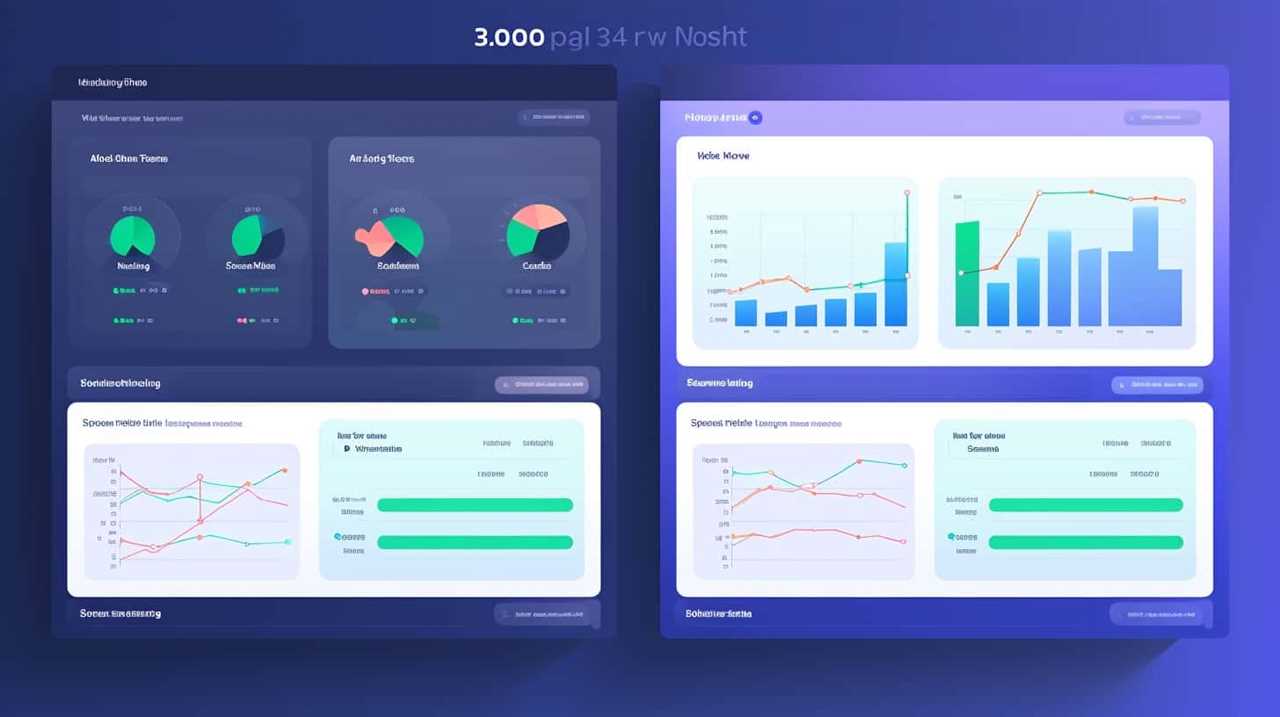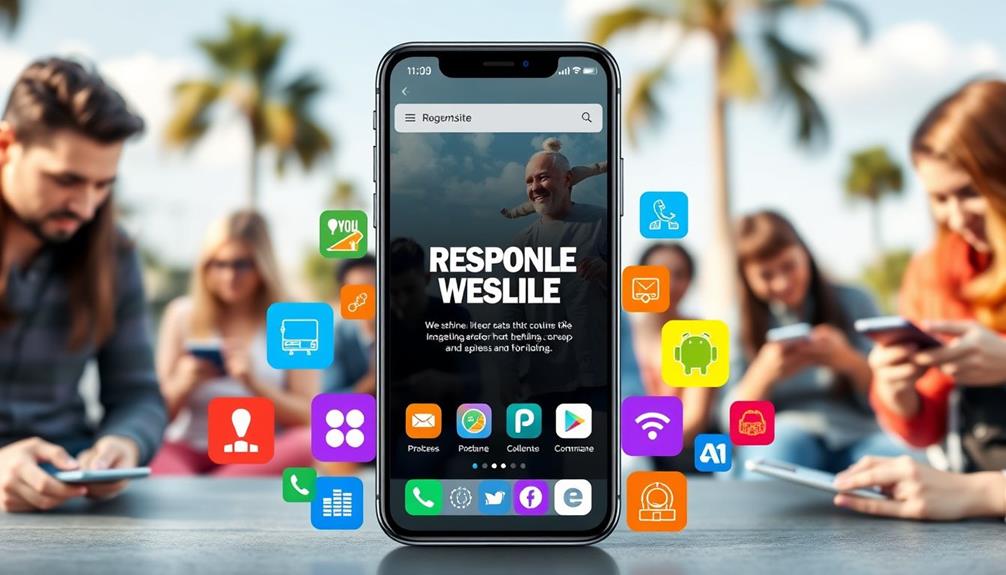Ready to take your environmentally friendly and sustainable business to the next level? Look no further.
In this article, we’ll delve into the world of organic growth and explore the powerful SEO techniques that can help your business thrive.
From sustainable practices to mobile-friendly optimization, we’ve got you covered.
Join us as we navigate the ever-changing landscape of SEO trends and discover how to measure your success in the world of eco-friendly businesses.

Let’s embark on this journey together.
Key Takeaways
- Organic growth is achieved through sustainable SEO techniques that prioritize user experience and provide valuable information to visitors.
- Adopting sustainable SEO practices helps businesses showcase their commitment to environmental responsibility and gain the trust of eco-conscious consumers.
- Keyword research and optimization are essential for attracting environmentally conscious consumers to eco-friendly businesses.
- Mobile-friendly optimization is crucial for sustainable SEO as mobile usage continues to rise and mobile-friendly websites rank higher in search results.
Understanding Organic Growth
To fully comprehend the concept of organic growth, it’s important for us to understand how search engine optimization (SEO) techniques contribute to the sustainable and eco-friendly success of businesses. Understanding organic growth involves recognizing the significance of sustainable SEO techniques in driving traffic, increasing visibility, and improving rankings on search engine result pages (SERPs).
Organic growth refers to the natural and steady increase in website traffic and customer engagement, achieved through ethical and sustainable means. It’s a long-term strategy that focuses on creating valuable content, optimizing website structure, and building high-quality backlinks. By utilizing sustainable SEO techniques, businesses can enhance their online presence while minimizing their impact on the environment.
Sustainable SEO techniques prioritize user experience by providing relevant and valuable information to website visitors. This includes creating useful and engaging content, optimizing website speed and mobile responsiveness, and ensuring easy navigation. Additionally, sustainable SEO emphasizes ethical link building practices, such as acquiring backlinks from reputable sources and avoiding spammy tactics.

Importance of Sustainable SEO Practices
We believe that implementing sustainable SEO practices is crucial for businesses aiming for long-term success and environmental responsibility. By adopting sustainable SEO strategies and engaging in eco-conscious keyword research, businesses can’t only improve their online visibility but also contribute to a greener and more sustainable future.
Here are four reasons why sustainable SEO practices are important:
- Reduced environmental impact: Sustainable SEO strategies focus on minimizing the use of resources such as energy and paper, reducing waste, and promoting eco-friendly practices. By implementing these strategies, businesses can minimize their environmental footprint and contribute to a healthier planet.
- Long-term viability: Sustainable SEO practices prioritize long-term results over short-term gains. By focusing on creating high-quality, valuable content that aligns with the needs and interests of their target audience, businesses can build a strong online presence that stands the test of time.
- Enhanced user experience: Sustainable SEO practices prioritize the needs and preferences of users. By optimizing website navigation, improving page load speed, and ensuring mobile-friendliness, businesses can provide a seamless and engaging user experience, leading to increased customer satisfaction and loyalty.
- Positive brand image: By adopting sustainable SEO practices, businesses can showcase their commitment to environmental responsibility and gain the trust and loyalty of eco-conscious consumers. A positive brand image can lead to increased customer engagement, higher conversion rates, and ultimately, business growth.
In the next section, we’ll explore the importance of keyword research for eco-friendly businesses and how it can further enhance their sustainable SEO practices.
Keyword Research for Eco-Friendly Businesses
For eco-friendly businesses, conducting keyword research is essential in order to optimize their online presence and attract environmentally conscious consumers. Eco friendly keyword research involves identifying and targeting specific keywords that are relevant to sustainable products, services, and practices. By incorporating these keywords into their website content, eco-friendly businesses can increase their visibility in search engine results and drive organic traffic to their site.

To start with eco friendly keyword research, businesses can use various tools and techniques. One approach is to brainstorm a list of keywords related to their industry and target audience. They can also analyze their competitors’ websites to identify the keywords they’re ranking for. Additionally, using keyword research tools like Google Keyword Planner or SEMrush can provide valuable insights into search volume, competition, and related keywords.
When conducting eco friendly keyword research, it’s important to focus on long-tail keywords that are specific to the sustainable products or services being offered. For example, instead of targeting a broad keyword like ‘eco-friendly clothing,’ a business could target a more specific keyword like ‘organic cotton T-shirts.’ This helps to attract highly targeted, environmentally conscious consumers who are actively searching for sustainable options.
Incorporating sustainable SEO techniques into keyword research can help eco-friendly businesses establish a strong online presence and connect with their target audience. By optimizing their website content with eco friendly keywords, businesses can increase their visibility, drive relevant traffic, and ultimately grow their sustainable brand.
Optimizing Website Structure for Sustainability
How can we ensure that our website structure is optimized for sustainability?

Optimizing website structure is an essential step in creating a sustainable online presence. By implementing sustainable web design practices and implementing green hosting solutions, we can minimize our environmental impact and contribute to a greener web.
Here are four ways to optimize your website structure for sustainability:
- Use clean and efficient code: By writing clean and efficient code, you can reduce the size of your website’s files, improving loading times and reducing energy consumption.
- Optimize images and media: Compressing images and optimizing media files can significantly reduce the amount of data that needs to be transferred, resulting in faster load times and lower energy usage.
- Minimize HTTP requests: Each HTTP request made by a web page requires server processing and increases the load time. Minimizing the number of requests can improve performance and reduce energy consumption.
- Choose green hosting providers: Look for hosting providers that use renewable energy sources or have a commitment to sustainability. Green hosting solutions can significantly reduce the carbon footprint of your website.
Creating High-Quality and Relevant Content
When it comes to creating high-quality and relevant content for sustainable and eco-friendly businesses, there are a few key points to consider.
First, conducting thorough keyword research is essential to understand what your target audience is searching for and to optimize your content accordingly.

Next, employing engaging storytelling techniques can help captivate your readers and convey your brand’s message effectively.
Lastly, don’t forget to optimize your content by using relevant headers, meta tags, and alt text to improve your search engine rankings and ensure your content is easily discoverable.
Keyword Research Strategies
To effectively create high-quality and relevant content, we rely on extensive keyword research strategies. By conducting thorough research, we gain valuable insights into the search terms and phrases that our target audience is using. This allows us to optimize our content and improve its visibility in search engine results.
Our keyword research strategies include:

- Long tail keyword research strategies: We focus on longer, more specific keyword phrases that have lower search volume but higher intent. This helps us attract highly targeted traffic and increase our chances of conversion.
- Competitor analysis for keyword targeting: We analyze the keywords that our competitors are targeting to identify opportunities and gaps in the market. This enables us to create content that stands out and offers unique value to our audience.
- Keyword research tools: We utilize various tools to identify relevant keywords and analyze their search volume, competition, and trends. This data helps us prioritize our content creation efforts and optimize our website for maximum visibility.
- User intent analysis: We go beyond just identifying keywords and strive to understand the intent behind them. This allows us to create content that not only matches the keywords but also provides valuable information and answers to our audience’s queries.
By employing these keyword research strategies, we can ensure that our content is highly targeted, relevant, and optimized for search engines. This will ultimately drive organic traffic to our website and help us achieve sustainable growth.
Now that we have a solid foundation in keyword research, let’s move on to exploring engaging storytelling techniques that will captivate our audience and further enhance our organic growth strategy.
Engaging Storytelling Techniques
We rely on incorporating engaging storytelling techniques to create high-quality and relevant content that resonates with our audience and enhances our organic growth strategy. Storytelling is a powerful tool that allows us to connect with our customers on a deeper level, making our brand more relatable and memorable.
By crafting compelling narratives, we can effectively communicate our values and mission, while also incorporating sustainability into our brand stories. Sharing stories about our eco-friendly practices and initiatives not only helps raise brand awareness but also inspires and educates our audience about the importance of sustainability.

Through storytelling, we can create a meaningful and authentic connection with our customers, fostering loyalty and driving organic growth for our sustainable and eco-friendly business.
Content Optimization Tips
To achieve optimal content optimization, our team focuses on incorporating strategic keywords and maintaining a balance between high-quality and relevant content. Here are some tips for creating high-quality and relevant content that will help improve your website’s visibility and organic growth:
- Conduct thorough keyword research to identify the most relevant and popular terms related to your business or industry.
- Use these keywords strategically throughout your content, including in headings, subheadings, and meta tags, to improve your on-page optimization.
- Create engaging and informative content that offers value to your audience. This can include how-to guides, tutorials, case studies, and industry insights.
- Regularly update and refresh your content to ensure it remains relevant and up-to-date.
Leveraging Social Media for Eco-Friendly Brands
Socially responsible businesses frequently leverage social media platforms to promote their eco-friendly brands. One effective strategy is to collaborate with influencers who have a strong following and share similar values. By partnering with influencers who are passionate about sustainability, these businesses can tap into their audience and amplify their message. Influencer collaborations can take the form of sponsored posts, product reviews, or even co-creating content that educates and engages followers about eco-friendly practices.
Another approach is to run eco-friendly social media campaigns that raise awareness and inspire action. These campaigns can be centered around specific environmental issues or promote sustainable lifestyle choices. For example, a brand may launch a campaign encouraging followers to reduce plastic waste by using reusable water bottles or shopping bags. By using hashtags and encouraging user-generated content, these campaigns can gain traction and reach a wider audience.

To optimize the impact of their social media efforts, businesses should ensure that their content is informative, engaging, and visually appealing. They should also consistently share content that aligns with their brand values and resonates with their target audience.
Building Backlinks From Ethical Sources
While collaborating with influencers and running eco-friendly social media campaigns, it’s important for sustainable and eco-friendly businesses to also focus on building backlinks from ethical sources to enhance their SEO efforts. Building backlinks from ethical sources not only improves search engine rankings but also helps in establishing credibility and authority in the industry.
Here are some effective strategies for sustainable link building through ethical outreach:
- Guest Blogging: Reach out to authoritative websites and offer to write guest blog posts that provide valuable information related to your industry. This allows you to gain exposure to a wider audience while also earning backlinks to your own website.
- Partnerships and Collaborations: Collaborate with like-minded businesses and organizations that share your sustainability values. By promoting each other’s content and linking to one another’s websites, you can expand your reach and build mutually beneficial backlinks.
- Resource Pages: Identify websites that have resource pages related to your industry or niche. Reach out to them and suggest adding your website as a valuable resource. This can lead to high-quality backlinks and increased visibility.
- Charitable Initiatives: Sponsor and support charitable organizations or events that align with your brand values. This not only helps you give back to the community but also provides an opportunity to earn backlinks from their websites.
Utilizing Local SEO Strategies for Sustainability
When it comes to sustainability, targeting niche local markets and building community partnerships are key strategies for businesses to consider.

By focusing on specific local areas, businesses can tailor their SEO efforts to reach their target audience more effectively. This can include optimizing website content with location-specific keywords and creating local business listings on directories such as Google My Business.
Additionally, forming partnerships with local organizations and participating in community events can help establish a strong presence and build trust within the community.
Targeting Niche Local Markets
We implement targeted local SEO strategies to reach niche markets and promote sustainability for our eco-friendly business. Targeting niche local markets is a crucial aspect of our marketing strategy, as it allows us to connect with specific communities that are aligned with our values and mission. By utilizing local marketing strategies, we can effectively reach eco-conscious consumers who are actively seeking sustainable products and services.
Here are some key ways we target niche local markets:

- Conducting keyword research to identify specific search terms that resonate with our target audience.
- Optimizing our website and content to rank higher in local search results.
- Creating location-specific landing pages to cater to the needs and preferences of different regions.
- Leveraging online directories and review platforms to increase our visibility and reputation in local markets.
By implementing these strategies, we can effectively reach and engage with our target audience, driving sustainable growth for our business.
Now, let’s explore how we build community partnerships to further enhance our sustainability efforts.
Building Community Partnerships
To enhance our sustainability efforts, we actively pursue community partnerships through the utilization of local SEO strategies. Building community engagement and establishing sustainable business partnerships are key components of our approach. By collaborating with local organizations, businesses, and community leaders, we can create a network that supports our eco-friendly initiatives.
One effective way we achieve this is through local SEO strategies. By optimizing our website for local keywords and creating localized content, we can attract and engage with the local community. This not only increases our visibility in local search results but also helps us connect with like-minded individuals and organizations who share our commitment to sustainability.

To illustrate the power of building community partnerships, here is a table showcasing some of the successful collaborations we have established:
| Partner | Collaboration |
|---|---|
| Local Environmental Group | Joint awareness campaigns and initiatives |
| Sustainable Farm | Sourcing organic produce for our eco-friendly café |
| Recycling Center | Co-hosting recycling drives and promoting waste reduction |
| Nonprofit Organization | Fundraising events and supporting community projects |
| Local School | Environmental education programs and workshops |
These partnerships not only benefit our business but also contribute to the overall well-being of the community. By working together, we can create a more sustainable future for everyone.
Implementing Mobile-Friendly SEO Techniques
Mobile optimization is essential for businesses looking to improve their search engine rankings and reach a wider audience. In today’s digital age, more and more people are using their smartphones and tablets to browse the internet, making mobile SEO a crucial aspect of any successful online strategy.
To help you implement effective mobile optimization strategies, here are four key considerations:

- Responsive Design: Ensure that your website is responsive and adapts seamlessly to different screen sizes. This will enhance user experience and encourage visitors to stay on your site longer.
- Page Speed: Optimize your website’s loading time for mobile devices. Slow-loading pages can lead to higher bounce rates and lower search engine rankings.
- Mobile-Friendly Content: Create content that’s easy to read and navigate on mobile devices. Use shorter paragraphs, larger fonts, and clear headings to make it more user-friendly.
- Local SEO: Mobile searches often have a local intent. Optimize your website for local keywords and include location-specific information to attract mobile users searching for nearby businesses.
By implementing these mobile-friendly SEO techniques, you can improve your website’s visibility, increase organic traffic, and ultimately grow your business in a sustainable and eco-friendly way.
Stay tuned for the next subtopic, where we’ll discuss the importance of social media integration in your SEO strategy.
Monitoring and Analyzing SEO Performance
After implementing mobile-friendly SEO techniques, it’s important for sustainable and eco-friendly businesses to monitor and analyze their SEO performance. SEO performance tracking allows businesses to assess the effectiveness of their SEO strategies and make necessary adjustments to improve their organic growth. Analyzing SEO data provides valuable insights into the performance of various SEO elements such as keyword rankings, website traffic, and user engagement.
One key aspect of SEO performance tracking is monitoring keyword rankings. By tracking the rankings of targeted keywords, businesses can determine whether their SEO efforts are generating visibility in search engine results pages. This data helps identify which keywords are driving traffic and conversions, allowing businesses to optimize their content and focus on high-performing keywords.

Additionally, analyzing website traffic and user engagement metrics provides valuable information about the effectiveness of SEO strategies. Businesses can use tools like Google Analytics to track metrics such as organic traffic, bounce rate, and average session duration. By analyzing these data points, businesses can identify areas for improvement and optimize their website to enhance user experience and increase conversions.
Regularly monitoring and analyzing SEO performance enables sustainable and eco-friendly businesses to make data-driven decisions and continuously improve their SEO strategies. By staying informed about keyword rankings, website traffic, and user engagement, businesses can optimize their SEO efforts and achieve long-term organic growth.
Staying Up-To-Date With SEO Trends in Sustainability
We regularly stay informed about the latest SEO trends in sustainability to ensure our organic growth as a sustainable and eco-friendly business. Staying up-to-date with these trends allows us to adapt our SEO strategies and stay ahead of the competition.
Here are some key points to consider when it comes to sustainable SEO techniques for small businesses:

- Content optimization: Creating high-quality, relevant, and engaging content is crucial for sustainable SEO. By incorporating keywords related to sustainability and eco-friendliness, we can attract our target audience and improve our search engine rankings.
- Mobile optimization: With the increasing use of mobile devices, optimizing our website for mobile users is essential. This includes ensuring fast loading times, responsive design, and easy navigation, all of which contribute to a better user experience.
- Social media engagement: Utilizing social media platforms allows us to connect with our audience, share valuable content, and build brand loyalty. By actively engaging with our followers and encouraging them to share our content, we can increase our online visibility and improve our SEO performance.
- User experience: The impact of user experience on sustainable SEO strategies can’t be overstated. By providing a seamless and enjoyable experience for our website visitors, we can increase dwell time, reduce bounce rates, and ultimately improve our search engine rankings.
Measuring Success: Metrics for Eco-Friendly Businesses
Measuring the success of eco-friendly businesses involves tracking key metrics that reflect their sustainable practices and impact. By quantifying sustainability efforts and gauging eco-friendly brand loyalty, businesses can gain valuable insights into their performance and make informed decisions for future growth.
One way to measure the impact of sustainability efforts is by tracking the reduction in carbon footprint. This can be done by monitoring energy consumption, waste production, and greenhouse gas emissions. By setting targets and regularly evaluating progress, businesses can ensure they are on track towards their sustainability goals.
Another important metric to consider is the percentage of recycled or renewable materials used in products or packaging. This not only showcases a commitment to eco-friendly practices but also provides a tangible measure of resource conservation.
Tracking customer engagement is equally crucial in measuring the success of eco-friendly businesses. This can be done by monitoring customer reviews, social media mentions, and brand loyalty. A high level of customer engagement indicates that the business’s sustainable practices resonate with consumers and can lead to increased brand loyalty and advocacy.

To summarize, measuring the success of eco-friendly businesses requires quantifying sustainability efforts and tracking customer engagement. By paying attention to these key metrics, businesses can assess their impact, make data-driven decisions, and continue to grow in a sustainable and eco-friendly manner.
| Metric | Importance |
|---|---|
| Reduction in carbon footprint | Reflects commitment to sustainability and tracks progress towards goals. |
| Percentage of recycled or renewable materials used | Measures resource conservation and environmental impact. |
| Customer reviews and social media mentions | Indicates customer engagement and brand loyalty. |
| Energy consumption and waste production | Quantifies environmental impact and identifies areas for improvement. |
| Brand loyalty | Gauges customer satisfaction and likelihood of repeat purchases. |
Conclusion
In conclusion, by implementing sustainable SEO techniques, eco-friendly businesses can experience organic growth and contribute positively to the environment.
With the right keyword research, optimized website structure, relevant content, and mobile-friendly SEO, these businesses can attract more traffic and increase their online visibility.
By monitoring and analyzing SEO performance and staying up-to-date with sustainability trends, they can measure their success and continue to make a positive impact.

So, let’s embrace these eco-friendly SEO practices and watch our businesses thrive while being kind to the planet.










